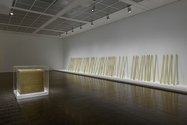Carmen Ansaldo – 6 April, 2014
'One More Than One' left visitors with one final quote from the artist: “I would like the work to be non-work. It is something, it is nothing.” Hesse’s use of repetition to communicate nothingness, to express her own fleeting mortality and to make material her sense of not knowing was one of her great achievements as an artist and as a human being.
Eva Hesse’s solo exhibition One More Than One focused on paintings, sketches and sculptures produced by the artist between 1966 and 1970 - the period which marked her most prolific output, as well as the last years of her life. Hamburger Kunsthalle co-curators Dr. Brigitte Kölle and Dr. Petra Roettig made the decision to forego a strict chronological hang of Hesse’s works in order to emphasise the often paradoxical struggle between her battle with terminal illness and her compulsive need to produce art.
Focusing on the artist’s personal struggle enabled Roettig and Kölle to foreground some of her other biographical details, the most significant being Hesse’s status as a Hamburg-born artist. The artist’s relationship to her hometown has often been overlooked by historians, due to the fact that Hesse and her family fled the Nazi regime for the United States when she was only two years old. One More Than One was installed alongside a retrospective of another prominent Hamburg-born sculptor, Gertrud Goldschmidt (a.k.a. Gego). The works of both artists spanned two gallery floors and included over 170 works - the largest presentation of both artists to ever take place in their hometown.
It would be a near impossible feat to present an exhibition of Hesse’s work through an entirely new critical lens and certainly, there were some aspects of One More Than One which seemed arbitrary. In particular, the simultaneous exhibiting of both Hesse and Gego ‘in dialogue’ with each other was unconvincing, as the two exhibitions appeared to have little commonality with each other aside from the biographical details of both being women artists born in Hamburg.
However, taken in isolation, the specific curatorial focus on the artist’s utilisation of the serial method during her last years of life did mount a compelling argument. One More Than One captured the struggles and discoveries of Hesse’s experiments during this time, and posited the use of repetition and series as her strategy for grappling with mortality and bodily immanence. Within each utilisation of the serial method, Hesse simultaneously privileged the systematic and the organic in ways previously unexplored within her circle of peers. Her concerns were often contrary to the pristine, clinical late-modernist series of the New York scene (Sol Lewitt, Donald Judd, Robert Morris, et al).
It was a rare occurrence to experience first-hand some of her most successful installations from this period, many of which were prevented from being exhibited extensively in Europe due to their ephemeral quality. Of particular note were Repetition 19 III (1968), Accretion (1968) and No Title (1970). The inclusion of these more ephemeral works enabled the exhibition to draw particular attention to the role of texture and material in Hesse’s series. Her repeated rendering of objects involved a uniquely abject and bodily aesthetic which revealed her interest in the presence of imperfection and the visibility of the artist’s hand. She was obsessed with the subtle divergences that the execution of repetition produced, and the way these discretions were compounded once materials changed or degraded over time.
Moving through the works of One More Than One, there were examples of Hesse’s repetitive method which were sentimental, some could be read as a type of scientific experiment, and others were wholly monstrous in their confrontation of nothingness. Similarly, the monochromatic scale of Hesse’s inks and drawings and her use of reductive shapes and lines were clearly executed with a knowing imperfection that would later, unknowingly, sow the seeds for the postmodern perspective. The audience’s collective awareness of this process being executed in the shadow of her impending death was palpable.
One More Than One left visitors with one final quote from the artist: “I would like the work to be non-work. It is something, it is nothing.” Hesse’s use of repetition to communicate nothingness, to express her own fleeting mortality and to make material her sense of not knowing was one of her great achievements as an artist and as a human being. An excerpt from Mel Bochner’s seminal essay ‘Serial Attitudes’ also accompanied Hesse’s quote: “Types of order are forms of thoughts.”
One More Than One confirmed this assertion. By utilising the serial method Hesse was asserting a statement of self, refusing to let the experimentation of her practice slip into the (understandable) pits of futility or despair. In this way, the exhibition was able to successfully marry some of Hesse’s strongest formal aesthetics and methodologies with the extraordinary biography of her last years.
Carmen Anseldo





 Advertising in this column
Advertising in this column Two Rooms presents a program of residencies and projects
Two Rooms presents a program of residencies and projects



This Discussion has 0 comments.
Comment
Participate
Register to Participate.
Sign in
Sign in to an existing account.